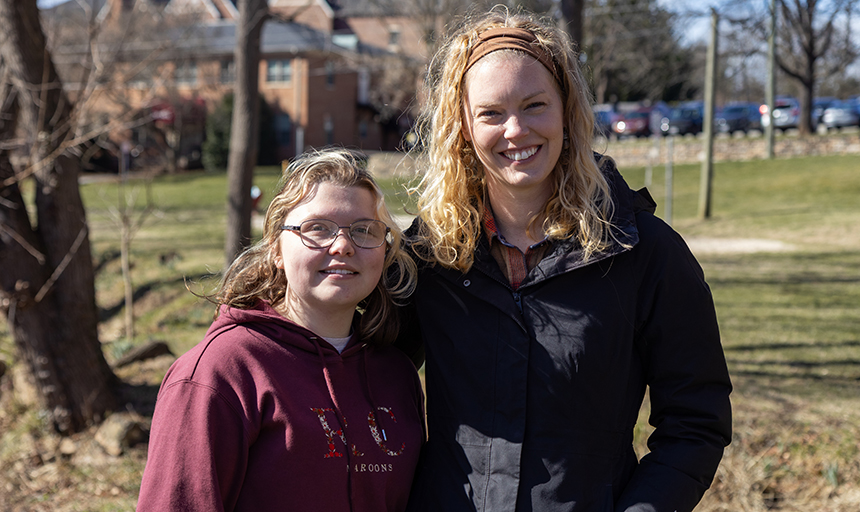Roanoke flood sensor project a finalist for Smart Cities award
March 01, 2024
Category: Real-World Learning

Two stream gauges installed on the Roanoke College campus through a Department of Homeland Security program are generating not only valuable flood-detection data, but also hands-on learning experiences for Roanoke College students.
Now, the project is a finalist in the seventh annual Smart Cities North America Awards. Voting for the award is open now through March 8, and anyone can visit the link to vote for the Department of Homeland Security (DHS)/Roanoke College Flood Sensor Program. The project can be found in Category 8, Next Generation Emergency Services. The system allows one vote per electronic device.
Chuck Kirby ’05, who earned a BA in political science at Roanoke and is now vice president for smart communities at the Virginia Innovation Partnership Corporation, approached Chelsea Peters, an assistant professor of environmental studies at Roanoke, about participating in the project. Peters immediately recognized its value as an early warning system for the campus, as well as an opportunity for experiential learning.
“Capturing real-time data on campus gives us the opportunity to closely study change on our campus,” Peters said, “not to mention the ability to keep our community informed and to better safeguard them and their belongings.”
The flood sensor units, manufactured by Intellisense Systems Inc., were installed on Snyder Branch Creek, a small tributary of the Roanoke River, in November 2022. Snyder Branch Creek runs through the north edge of campus near Hawthorn Road, then dives underground and travels through a culvert beneath the College’s athletic fields before resurfacing near the Bast Center and running past the Wortmann Complex.
Peters described the creek as “flashy,” which means it can rise and fall quickly in response to storm events, posing a risk of flash flooding. One sensor was installed near the Wortmann Complex and the other near Hawthorn Road. The gauges run on solar power and transmit real-time data, including stream depth and temperature, through cellular connectivity. Peters and one of her research fellows, Makenna Keith ’27, monitor the data through a web dashboard.
"Capturing real-time data on campus gives us the opportunity to closely study change on our campus."
Assistant Professor Chelsea Peters
Over the past seven days, for example, the creek showed a low depth of 3.5 inches and a high of 10.6 following mid-week rains. When the depth reaches an established threshold, such as 23 inches near the Wortmann Complex, it triggers an alert that is received by Peters, as well as the College’s Office of Campus Safety and Buildings and Grounds teams. The early warning allows time for officials to issue alerts to the campus community.
Since the program’s inception, about 130 of the gauges have been installed throughout Virginia, and they have generated nearly 9,000 flood alerts. Although it is a nationwide program, Roanoke College is the only liberal arts college in America that is part of the project.
Having access to the sensors and their data presents rich opportunities for student involvement. Keith, who hopes to work in an environmental field after graduation, is responsible for monitoring the dashboards and physically checking on both gauges to make sure they are clear of debris and working properly.
Others use the data to better understand stream dynamics and flood risk. For example, students in an environmental science course called Water and Society created stream hydrographs and rating curves from the gauge water height data, which allowed them to calculate the watershed budget of the Snyder Branch Creek Basin.
The flood sensor project also dovetails nicely with a stream restoration effort at Snyder Branch Creek that was initiated by the fall 2021 environmental studies senior practicum class. That class, and several student groups since, have worked to remove invasive species and plant native riparian plants along the creek banks. Seasonal plantings will continue until the stream is buffered by a healthy, native plant border.
Other classes have studied stream flow using rubber duckies on the creek or analyzed insect and fish species in and around the creek.
“It’s extremely valuable to have this space as an outdoor laboratory for our faculty, staff and students,” Peters said.
Vote for Roanoke College in the Smart Cities contest. Roanoke's project is under Category 8.

A sign along Snyder Branch Creek explains the flood sensor and creek restoration projects at Roanoke College. To the left is one of the stream gauges that is measuring creek height and temperature, then sending data back to a web dashboard for analysis.